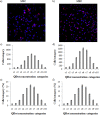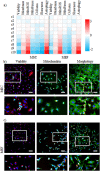High content analysis at single cell level identifies different cellular responses dependent on nanomaterial concentrations
- PMID: 26345238
- PMCID: PMC4561960
- DOI: 10.1038/srep13890
High content analysis at single cell level identifies different cellular responses dependent on nanomaterial concentrations
Abstract
A mechanistic understanding of nanomaterial (NM) interaction with biological environments is pivotal for the safe transition from basic science to applied nanomedicine. NM exposure results in varying levels of internalized NM in different neighboring cells, due to variances in cell size, cell cycle phase and NM agglomeration. Using high-content analysis, we investigated the cytotoxic effects of fluorescent quantum dots on cultured cells, where all effects were correlated with the concentration of NMs at the single cell level. Upon binning the single cell data into different categories related to NM concentration, this study demonstrates, for the first time, that quantum dots activate both cytoprotective and cytotoxic mechanisms, resulting in a zero net result on the overall cell population, yet with significant effects in cells with higher cellular NM levels. Our results suggest that future NM cytotoxicity studies should correlate NM toxicity with cellular NM numbers on the single cell level, as conflicting mechanisms in particular cell subpopulations are commonly overlooked using classical toxicological methods.
Figures




References
-
- Hansen S. F., Maynard A., Baun A. & Tickner J. A. Late lessons from early warnings for nanotechnology. Nature Nanotech. 3, 444–447 (2008). - PubMed
-
- Kim J. A., Aberg C., Salvati A. & Dawson K. A. Role of cell cycle on the cellular uptake and dilution of nanoparticles in a cell population. Nature Nanotech. 7, 62–68 (2012). - PubMed
Publication types
MeSH terms
LinkOut - more resources
Full Text Sources
Other Literature Sources

